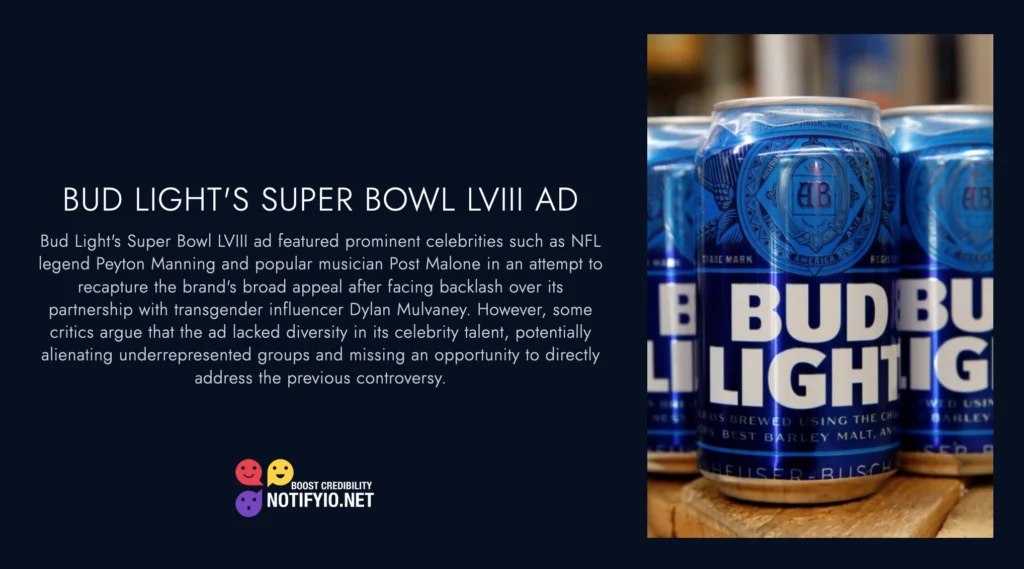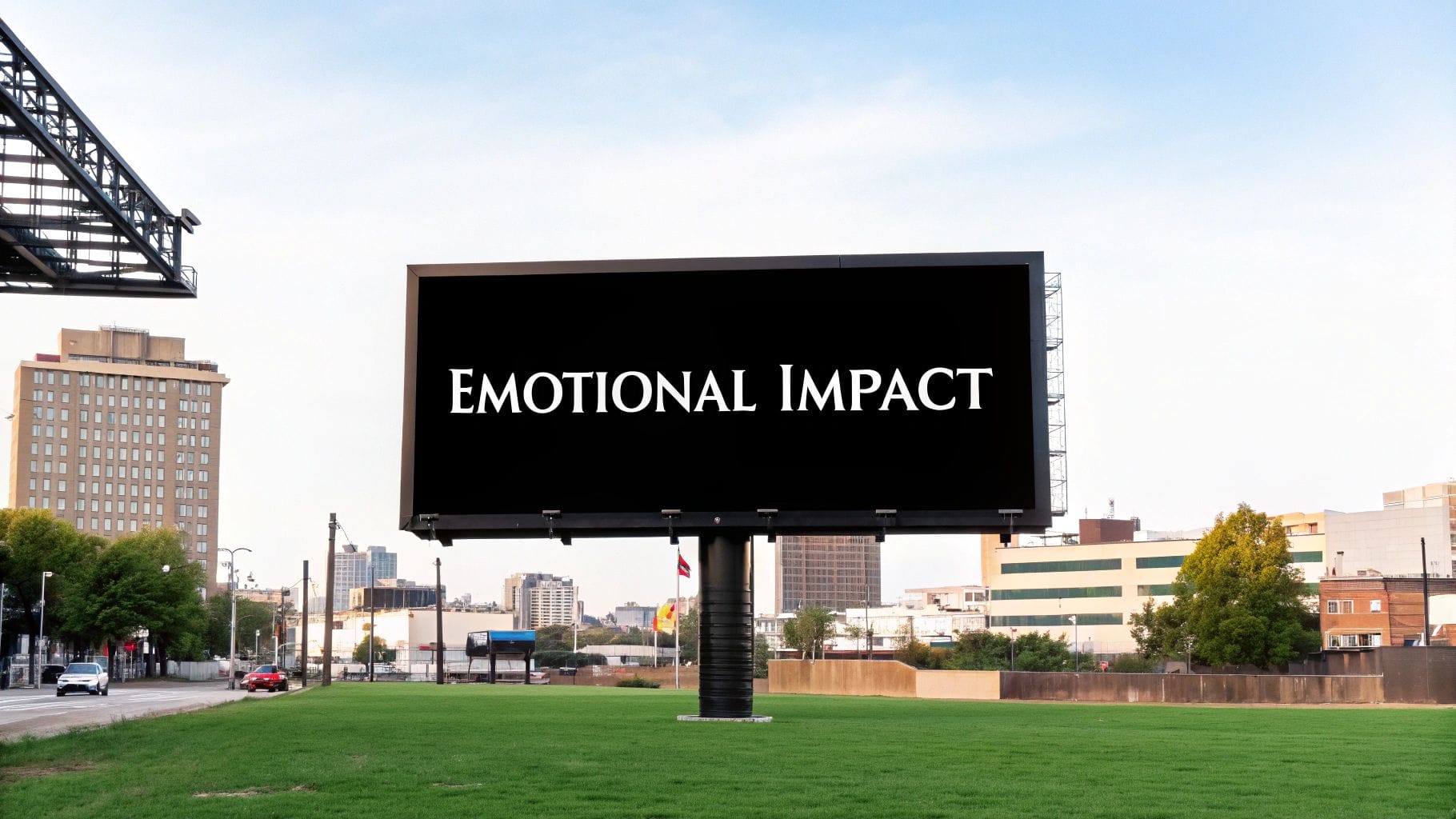In the changing world of marketing strategy, Bud Light made some bold moves recently. Their partnership with trans influencer Dylan Mulvaney caused a big stir. This led to backlash and people saying they’d stop buying the beer. As a result, the parent company Anheuser-Busch lost a lot of money, about $6 billion in 2023.
Bud Light is now working hard to get back in people’s good graces. They’ve focused on getting famous people involved, like football star Peyton Manning and music legend Post Malone. Their ad in the Super Bowl LVIII, with these stars, is a big example of this. Yet, some think the ad should have been more inclusive, so as not to leave some groups feeling left out.

Key Takeaways
- Bud Light faced significant backlash and boycott after partnering with transgender influencer Dylan Mulvaney.
- The brand’s Super Bowl LVIII ad features prominent celebrities like Peyton Manning and Post Malone in an effort to appeal to a broad audience.
- Some critics argue that the ad lacks diversity in its celebrity talent, potentially alienating underrepresented groups.
- Anheuser-Busch reported a $6 billion revenue loss following the controversy surrounding the Mulvaney partnership.
- The brand’s endorsement strategy highlights the challenges of balancing diverse consumer perspectives and promoting inclusivity.
Bud Light’s Super Bowl LVIII Ad: A Safe Bet or Missed Opportunity?
After facing criticism over a partnership with Dylan Mulvaney, Bud Light launched a 60-second ad at Super Bowl LVIII. This ad was a chance to get back in consumers’ good graces. It was under the “Easy to Drink, Easy to Enjoy” theme and stars like Peyton Manning and Post Malone were in it.
The ad had safe, crowd-pleasing topics and popular faces. But, some think Bud Light should have said something about the controversy. They say the brand could have shown it supports everyone. Without mentioning Mulvaney, Bud Light ignored a big issue.
Despite the backlash from its collaboration with the transgenderinfluencer Dylan Mulvaney, Bud Light’s Super Bowl LVIII ad made no mention of the controversy, potentially alienating those who supported the inclusive messaging.

People also noticed the ad’s celebrity choice wasn’t very diverse. They think Bud Light should have used this big stage to show more types of people. This would have connected with what society is moving toward.
It’s tough for brands to stand with current values while not losing their wide audience. Bud Light stayed on the safe side with its ad. Still, not touching on important topics like diversity and inclusion might have been a mistake.
The Impact of Celebrity Endorsements: Pepsi, Nike, and Anheuser-Busch
Celebrity endorsements help brands lift their image and reach fans. For example, Pepsi does this well with celebs like Zach Bryan. Still, Anheuser-Busch faced criticism over choosing Mulvaney for bud light’s ads.
The Backlash Against Bud Light’s Dylan Mulvaney Partnership
When Bud Light teamed up with Dylan Mulvaney, there was huge uproar. Sadly, the negative reaction caused a $6 billion loss for Bud Light. This points out the dangers of picking the wrong star to sell with.
The Power of Representation and Visibility
Despite risks, Mulvaney and Bud Light brought important change. They showed more of the transgender community in ads and media. This is a big step forward for companies working with diverse groups and for our view of LGBTQ+ people.
Mulvaney’s Bud Light deal highlights the big issues and chances in ads today. It shows how matching a brand like Bud Light with a right celebrity can win big but also lose big.
Bud Light’s Brand Perception and Consumer Sentiment
Bud Light teamed up with Dylan Mulvaney for endorsements. This choice stirred up a lot of talk, especially among Republican and Baby Boomer fans. They weren’t happy and it showed in how they reacted online.

Brand Loyalty and Lost Consumers
By using famous faces like Peyton Manning and Post Malone, Bud Light hoped to win over many people. However, they ended up losing some of their most loyal fans. The online criticism from those who hold more conservative views highlighted how risky these endorsements can be.
Generational and Political Divides
The debate over Mulvaney’s endorsement has shown a split in opinions. Younger, more liberal crowds, such as Gen Z and Democrats, are more positive. On the other hand, older and more conservative folks are taking longer to warm up to Bud Light. This challenge highlights the difficulty brands face in pleasing such different groups.
As a consumer thinks of a celebrity, they endorser was likely selected not only for their ability to promote a product but also for the values and associations they bring to the partnership.
Going ahead, Bud Light needs to tread carefully to bridge these divides. They have to connect with their target crowd while keeping a message of unity and representation. This incident is a clear sign of how impactful celebrity partnerships can be on a brand’s image and customer support.

Bud Light’s Marketing Strategy: Playing It Safe or Missing the Mark?
Bud Light’s ad for Super Bowl LVIII played it safe with easy-to-drink beer and famous faces like Peyton Manning. It aimed to please many. Yet, some say it didn’t try hard enough to support diversity and inclusion.
Appealing to a Broad Audience or Alienating Diverse Demographics?
The ad mainly used straight, white male stars. This could make other groups feel left out. Some think this approach didn’t help the brand show it cares about everyone.
Finding the right mix between wide appeal and inclusivity is tough. An issue arose with a backlash against Bud Light partnering with a transgender influencer. Critics accused the brand of not reacting well to the situation.
Just as two nodes that become linked in minds by appearing together in advertising campaigns, celebrities behaving badly can lead to negative associations transferring to the brand. Conversely, partnerships with historically marginalized groups may also be an aspirational element, likely for both business and societal reasons.
New issues are turning inclusivity into a political topic. Reaction to Mulvaney’s situation focused on the parent company. It showed people get upset when a chosen celebrity doesn’t match with the brand well.

Brands face a hard choice, seeking true representation without losing important consumers. For example, Nike stayed with Woods through his troubles. Meanwhile, Adidas and Gap dropped their troubled stars. This shows the complexities that brands have to deal with.
Conclusion
Bud Light’s way of getting famous, like its ad at Super Bowl LVIII and teaming up with Dylan Mulvaney, make a big fuss. They hope to get back people who stopped buying their stuff and make lots of people like their ads. Yet, it’s a challenge to make everyone happy while showing fair and important stories. This debate shows us the good and bad of getting famous people to say they like a product. It also shows how different people feel about this, based on their age or ideas about the world.
Bud Light and others must think about what we all believe and balance being popular with being fair to everyone. When Bud Light worked with Mulvaney, who is transgender, some people were mad. This anger cost Bud Light’s owner, Anheuser-Busch, a lot of money. But younger and more open-minded people liked it, because it showed everyone being treated equally.

Looking ahead, Bud Light wants to get fans back by ads like the one at Super Bowl LVIII with stars such as Peyton Manning and Post Malone. Yet, some think these ads don’t show enough different kinds of people. They worry that not everyone will feel included. So, for brands like Bud Light, finding a way to be liked by everyone, while sticking to what they believe, is very important.
FAQ
What was the controversy surrounding Bud Light’s partnership with Dylan Mulvaney?
Bud Light got in trouble by teaming up with Dylan Mulvaney. As a transgender influencer, Mulvaney faced a lot of mean talk and got unwanted attention online. This made Bud Light’s parent company lose $6 billion.

How has Bud Light’s brand perception and consumer sentiment been impacted by the controversy?
The company’s image and how much people want to buy Bud Light fell, a company called YouGov found. Especially, older people and those who lean Republican weren’t happy. Yet, new fans from Gen Z and Democrats show they like how Bud Light includes everyone.
What message does Bud Light’s partnership with Dylan Mulvaney send about representation and visibility?
Mulvaney and Bud Light’s work shows more of the transgender community in ads. This is new and shows changing times. It makes room for more companies to work with people who usually don’t get a spotlight. The ad world can be more welcoming this way.
What is the focus of Bud Light’s Super Bowl LVIII ad, and what criticism has it received?
Bud Light wanted Super Bowl LVIII to fix its image after the Dylan Mulvaney issue. It used fun topics and famous people to do this. Some experts think Bud Light missed a chance to talk about the problem and better represent everyone in the ad.
How does the Bud Light controversy highlight the potential risks and rewards of celebrity endorsements?
Pepsi and Nike have done well with famous people in their ads. But Bud Light’s issue with Dylan Mulvaney shows it can go wrong too. It’s a lesson on using stars in ads. Done right, it can help everyone feel like they belong in ads and in the world.




Leave a Reply